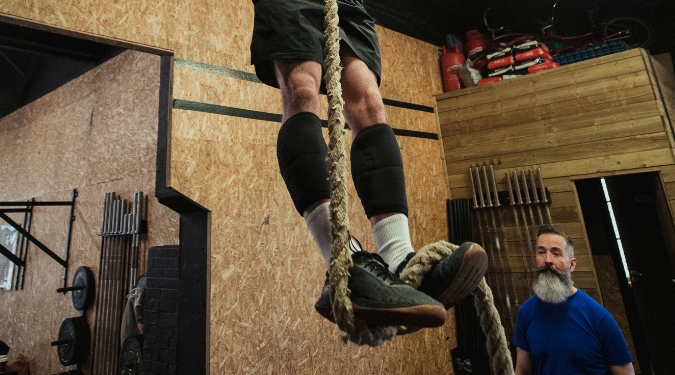For me, the first time I faced the climbing rope in the box, my mind traveled back 30 years in time, to my school, where I saw those kilometer-long ropes up to the ceiling that seemed unreachable to me (I never had to climb them, luckily). And in the box, I feared exactly that, not being able to climb it.
The rope is an element that, despite being very common in Cross Training boxes, so much so that it has even had several appearances in the CrossFit Games, is not present in our daily lives. I mean that it is difficult for us to transfer the movement to our daily lives, as for example we do with the squat to bend over, or with the deadlift to lift shopping bags.
What is a climbing rope?
It is made up of a network of finer ropes made of natural materials such as hemp, or synthetic polypropylene.
Types of climbing rope
Natural strings have better grip and are somewhat softer, but they deteriorate with the sun and humidity, and tend to release “lint” (natural fibers) due to initial wear.
Synthetic hemp ropes can be a bit slippery at first, but after the first few uses and applying magnesium, this will improve. In their favour, they do not shed fibres and are perfectly resistant to the elements, both humidity and sun, so they are ideal for training outdoors.
Where can we put the rope?
When it comes to anchoring them, we can do so to the ceiling or to the rack. The ceiling is usually done with climbing carabiners that are hooked to one end of the rope that has a metal piece that clamps the rope and leaves a small ring free.
Also, if we use large carabiners, we can use ropes with loops . The loop is a fold in the rope that is protected with heat-sealed fiber to prevent the carabiners or the rope itself from rubbing together.
We can also anchor the rope to the rack with a carabiner, but we would lose climbing height. The ideal is to “hang” a beam or crossbar of the rack, so we can climb higher. For this, it is better for the end of the rope to go with that eyelet or thimble (metal protector).
Regarding the length of the rope , if you have too much and it falls to the ground, its own weight will help you keep it stable. If it is too short, it will be harder to get hold of it at first.
The standard rope thickness is 38mm, which is quite demanding on your forearms.
First steps to rope climbing in crossfit
If you have never climbed a rope, your trick will be to “pin it” with your feet. Because, my friend, you can climb a rope with many things, and it is not always your arms.
Let's start easy , sit on a box and place the rope hanging on the outside of one of your legs.
Next, with your other foot, gather up the excess rope with the toe and wrap it around your free foot. If you've done it right, your free foot will have rope underneath it and on the inside, and that inner piece of rope is what you step on with your other foot to climb.
Practice this gesture at first, the one of winding the rope. Once you have mastered it, we will begin step 2.
Still sitting, grab the rope with your arms as high as you can and raise your knees as high as you can. Now we do the grip and you will notice that you have your legs up, well, extend them while you step and you will see how you magically ascend without using almost any force with your arms. That is the trick, climb the rope with your legs using your arms only to hold yourself up.
Step 3, already standing, jump and try to grab the rope as high as possible, so as not to tire your arms too much, raise not only your knees but your entire hips as high as you can, also raising your knees and doing the pinch.
When extending we will rise as much as we have raised the hip.
Supertip for climbing the rope
When climbing the rope, wear high socks, it's easy to get rope burn!

How to control the descent on the rope
Once we have mastered the climb, we have to descend. Just like the climb, if we descend using our arms to stop, we will be making a brutal effort.
It is best to practice descending by braking the grip we have made with our feet and taking care not to burn our thighs or hands. Practice from low heights first.
Climbing the rope can be hard at first, but so was the snatch or handstands, the important thing is to practice and improve.



Leave a comment
This site is protected by hCaptcha and the hCaptcha Privacy Policy and Terms of Service apply.